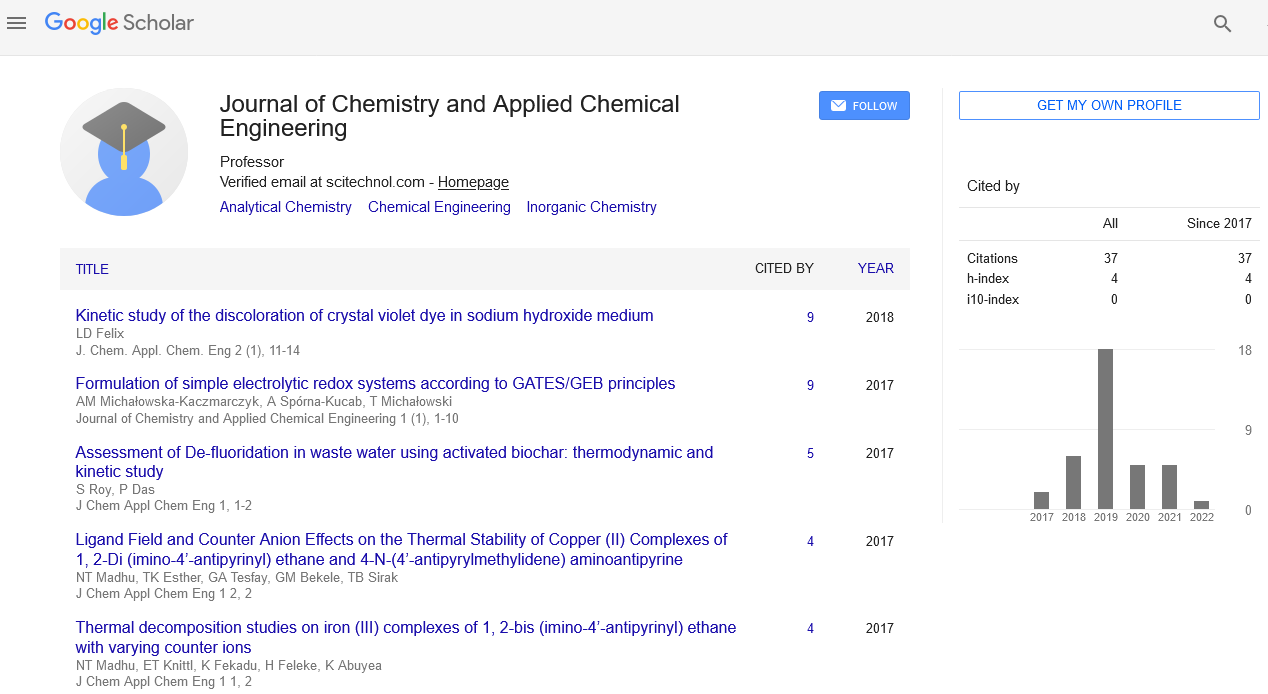Perspective, J Chem Appl Chem Vol: 7 Issue: 2
Exploring Molecules through Computational Chemistry
Liliana Smirniotis*
1Department of Chemical & Environmental Engineering, University of Cincinnati, Cincinnati, USA
*Corresponding Author: Liliana Smirniotis,
Department of Chemical &
Environmental Engineering, University of Cincinnati, Cincinnati, USA
E-mail: smirniotisliliana@gmail.com
Received date: 23 May, 2023, Manuscript No. JCACE-23-106773;
Editor assigned date: 25 May, 2023, Pre QC No. JCACE-23-106773 (PQ);
Reviewed date: 08 June, 2023, QC No. JCACE-23-106773;
Revised date: 15 June, 2023, Manuscript No. JCACE-23-106773 (R);
Published date: 22 June, 2023, DOI: 10.4172/Jcace.1000022
Citation: Smirniotis L (2023) Exploring Molecules through Computational Chemistry. J Chem Appl Chem Eng 7:2.
Description
Computational chemistry is a branch of theoretical chemistry that employs computer simulations and mathematical algorithms to understand and predict the behavior of molecules and chemical systems. It is an essential tool for modern research, as it provides insights into complex chemical phenomena that are challenging to study experimentally alone. By combining principles from physics, mathematics, and chemistry, computational chemistry enables scientists to study the electronic structure, dynamics, and properties of atoms and molecules.
The foundation of computational chemistry lies in quantum mechanics, a fundamental theory of physics that describes the behavior of particles at the atomic and subatomic levels. In computational chemistry, quantum mechanics is used to solve the Schrödinger equation, which describes the quantum state of a molecule. The main challenge in computational chemistry is that the Schrödinger equation is notoriously difficult to solve for systems containing many atoms due to its complexity. To overcome this, various approximation methods are used, such as Hartree Fock, Density Functional Theory (DFT), and post Hartree Fock methods like Moller Plesset perturbation theory and coupled-cluster theory.
One of the primary objectives of computational chemistry is to calculate the electronic structure of molecules, which provides insights into their stability, reactivity, and spectroscopic properties. These calculations help chemists understand reaction mechanisms, design new drugs, and optimize catalysts, among other applications. The accuracy of electronic structure calculations depends on the level of theory and the basis set used. More advanced methods can include electron correlation effects, which account for the interactions between electrons not considered in simple Hartree Fock calculations.
Another important aspect of computational chemistry is Molecular Dynamics (MD) simulations. MD simulations track the positions and velocities of atoms in a system over time, providing information about molecular motion, thermodynamics, and kinetics. MD simulations are particularly useful in studying protein folding, drug binding, and chemical reactions occurring on microsecond to millisecond timescales. The accuracy of MD simulations depends on the force field used, which describes the potential energy surface of the system and the forces between atoms.
Computational chemistry also plays a significant role in drug discovery and development. By using virtual screening techniques, computational chemists can efficiently search large databases of chemical compounds to identify potential drug candidates. Molecular docking studies predict the binding affinity and orientation of a ligand to its target protein, aiding in drug design and optimization. Furthermore, molecular dynamics simulations help in understanding the behavior of drug molecules in a biological environment, improving the efficiency of drug development pipelines.
In materials science, computational chemistry is valuable for understanding the structure and properties of materials at the atomic level. By simulating the properties of materials, such as strength, conductivity, and reactivity, researchers can design novel materials with tailored characteristics for specific applications. This is especially relevant for advanced materials like nanoparticles, graphene, and metal-organic frameworks.
The power of computational chemistry is further enhanced through the use of High-Performance Computing (HPC) resources. The large computational demands of many quantum mechanical calculations and molecular dynamics simulations necessitate access to supercomputers and parallel processing techniques.
Despite the numerous successes of computational chemistry, it also faces some challenges. Many calculations are still computationally expensive and time-consuming, limiting their applicability to large systems and long timescales. Additionally, some chemical processes, such as those involving strong electron correlation or quantum effects, remain difficult to model accurately.
Computational chemistry is a vital and dynamic field that bridges theory and experiment. It plays an important role in advancing our understanding of molecular phenomena, drug design, materials science, and various other disciplines. As computational resources and theoretical methods continue to evolve, computational chemistry's impact on scientific research is bound to grow, opening new avenues for discovery and innovation.
 Spanish
Spanish  Chinese
Chinese  Russian
Russian  German
German  French
French  Japanese
Japanese  Portuguese
Portuguese  Hindi
Hindi 